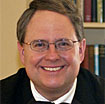Commentary on Mark 10:32-52
Mark 10:32-52 comprises three interrelated but separable units.
All constitute the third revolution of a quadripartite cycle, begun at 8:27-9:1 and repeated in 9:30-37.
Location | Prediction of the Son of Man’s Destiny | Disciples’ Misunderstanding | Teaching about Discipleship |
Mark 8:27 | 8:31 | 8:32-33 | 8:34–9:1 |
Mark 9:30 | 9:31 | 9:32-34 | 9:35-37 |
Mark 10:32 | 10:33-34 | 10:35-41 | 10:42-45 |
The entire cycle is bookended by Mark’s only stories of the healing of the blind (Mark 8:22-26; 10:46-52). That cannot be accidental. As in John 9:1-41, blindness is a metaphor for inability or refusal to acknowledge Jesus for who he truly is; vision, a trope for acceptance of him and of his teaching.
Part 1. Jesus’ third prediction of his destiny (verses 32-34)
“On the road” or “way” (hodos) refers to a path both geographical (Mark 1:2) and theological (Mark 1:3). In Mark (3:22; 7:1; 10:33) Jerusalem is a source of hostility; thus, those following Jesus may be “amazed” and “afraid.” Of the three prophecies in this central Markan cycle, Mark 10:33-34 is the most detailed: an epitome of the passion narrative (chapters 14-16). Compared with Mark 8:31 and Mark 9:31, Mark 10:33-34 draws out the collusion between Jewish and Gentile authorities and catalogues the Son of Man’s abuse before his death and resurrection.
Part 2. Discipleship bogus and bona fide (verses 35-45)
Mark’s implied motto for the Twelve is “If at first you don’t perceive, fail, fail again.” In Mark 8:32-33 Peter rebuked Jesus’ teaching; in turn, he was rebuked as “Satan,” diverting his teacher from the way that must be trod. In Mark 9:33-34, the Twelve bickered over rank. In Mark 10:35-37, James and John’s insinuation with Jesus is multiply inappropriate:
- Their plea is unqualified (verse 35), detached from faithful prayer upon which Jesus insists (Mark 9:29; 11:22-25) and inconsistent with the attitude of others who seek his help (Mark 2:5; 5:34; 9:23-24).
- This is a flagrant petition for patronage, which Jesus has granted nowhere in Mark.
- A request to be seated on either side of Jesus “in [his] glory” (Mark 10:37) disregards everything he has emphasized in the Son of Man’s destiny to suffer (Mark 8:31; 9:31; 10:33-34).
- By paraphrasing Herod’s disastrous impetuosity to Herodias’ daughter (Mark 6:22-23), the Zebedees ape the way this world’s rulers throw their weight around (see also Mark 10:42). Worse, they appeal for places of supreme honor—“at your right hand”—to which only the LORD’s regents are entitled (Psalm 110:1; Mark 14:62).
- Those positions on Jesus’ “right and left” will soon be assumed by faithless rebels crucified with Jesus (Mark 15:27, 32) after the Twelve have vamoosed (Mark 14:27, 50-52).
Repudiating Jesus as the suffering Son of Man, the Twelve continue to jockey for his favoritism.
Putting matters mildly, Jesus replies that they know not what they ask (Mark 10:38a). He inquires of their ability “to drink the cup that I drink, or be baptized with the baptism that I am baptized with” (Mark 10:38b). In Scripture, a “cup” may symbolize either joyful salvation (Psalm 23:5; 116:13) or woebegone judgment (Psalm 11:6; Isaiah 51:17).
Very early, both baptism and the Lord’s supper were interpreted as participation with Jesus in his death (Romans 6:3-4; 1 Corinthians 11:25-26). The wires are crossed: salivating over blessings that accompany exaltation with Jesus in glory (Mark 10:37), James and John assert their capability (verse 39a). Jesus refers to a cup and a baptism with baleful consequences (verse 38; see also Mark 9:12-13; 14:38). He does not deny for his followers suffering for the gospel’s sake, like Jesus’ own (Mark 10:39b; 8:34-35; 13:9-23). What he refuses them are places of honor. These are not his to grant; they are God’s prerogatives (Mark 10:40). To the very end Jesus refuses any authority not been consigned to him by God (Mark 9:37b; 12:6-7; 14:21a), whose will is absolutely final (Mark 3:35; 10:6-9; 12:17a; 14:36).
Predictably, the others in Jesus’ entourage take umbrage at the Zebedees’ maneuvering (Mark 10:41). He reunites all Twelve for teaching about authentic discipleship (verses 42-45). This world’s construction of authority, which James and John have projected onto the end time (verse 37), is altogether fallacious. Status-relations determined by the Son of Man upend conventional expectations (verse 43). In Mark 9:36-37, the “servant” is aligned with “a little child.” In Mark 10:44, the “servant” slides into “everyone’s slave” (panton doulos): a self-derogation even more offensive.
Although slavery in antiquity carried varied connotations, it was generally considered a miserable form of life. In Mark 10:44, the status of slavery has become radically normative for Jesus’ disciples, because the Son of Man came not to be served but to serve. Jesus is not a new master. Instead, as “a ransom [lytron] for many,” he releases others from their enslavement (Mark 10:45; see also Mark 14:24; Exodus 21:30; Leviticus 25:47-52; Numbers 3:44-51).
Part 3. Bartimaeus (verses 46-52)
At Jericho, twenty miles northeast of Jerusalem, Jesus encounters Bartimaeus, blind and begging (verse 46; certainly not “lording it over” anyone [verse 42]). Repeatedly he cries out, “Jesus, Son of David, have mercy on me” (Mark 10:47-48). David was considered the LORD’s special regent (2 Samuel 7:4-17; Psalm 89:3-4); therapeutic powers were associated with David’s son (Matthew 9:27-31; 12:22-23).
Mark adroitly remodels a miracle story into a vignette of discipleship. The stern rebuke (epetimon) of the needy (Mark 10:48a) is a flashback to the disciples’ rebuke (epetimesen) of little children (Mark 10:13); now as then Jesus insists on receiving a needy petitioner (verses 14, 49). “Throwing off his cloak” (verse 50a) recalls those encumbrances that Jesus’ disciples should shed (Mark 6:8-9; 13:16).
Jesus’ question to Bartimaeus (Mark 10:51a) is identical to that which he asked James and John (verse 36). They blindly plumped for glory (verse 37); Bartimaeus insightfully pleads, “My teacher, let me see again” (verse 51). Unlike the Twelve (verses 38a, 41), this fellow knows what he is asking; his appeal springs from restorative faith, as Jesus acknowledges (verse 52a). Bartimaeus’ request is immediately fulfilled: he regains sight (Mark 10:52b). He moves from the wayside (verse 46b) onto “the way,” following Jesus (verse 52b): Mark’s capsule metaphor for discipleship (Mark 1:18; 2:14; 8:34; 10:21; 15:41).
The sightless see; the sighted are blind (see also John 9:39). This is a hard saying. Who can listen to it?
PRAYER OF THE DAY
Lord Jesus, it was hard for your disciples to hear that they would have to suffer in order to follow you. Give us faith and courage to follow you when following is painful or frightening. Amen.
HYMNS
I’m so glad Jesus lifted me ELW 860, NCH 474, TFF 191
Healer of our every ill ELW 612, GG 795
CHORAL
Balm in Gilead, Jackson Berkey


March 8, 2020